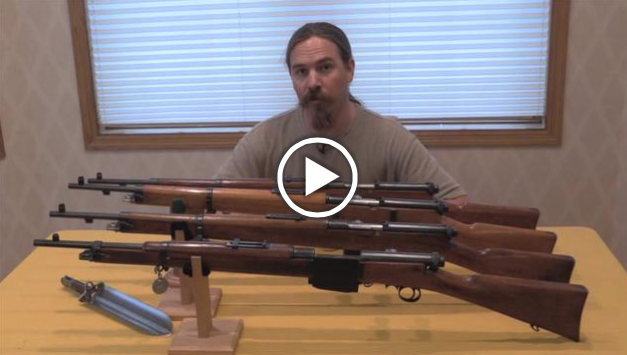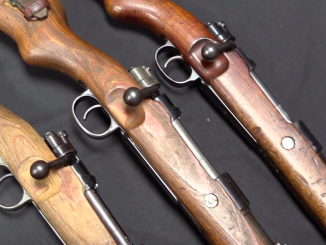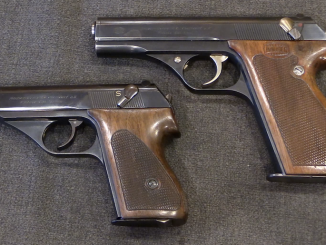As soon as the MG08/15 “light” machine gun was adopted by Germany, it was recognized as an ideal basis for an aircraft gun. Weight was of the essence for WW1 aircraft, and a lightened Maxim was just the thing to use. So the Spandau Arsenal began producing the LMG08/15 (the “L” in which might stand for either air-cooled or lightweight; we really don’t know which) in May 1916. In addition to cutting a ton of lightening slots in the water jacket, the guns also had mechanisms added to allow a pilot to cycle both the bolt and the feed system from behind the gun (something not possible with a standard ground model). The example we are looking at today has a great example of an early style of such device completely intact…
Related Articles

Semiauto Rifles
Mondragon 1908 Semiauto Rifles – 4 Different Examples (Video)

Bolt Action Rifles


Original configuration can be seen at well-known photo showing inspection of guns retrieved from Manfred Albrecht Freiherr von Richthofen’s aeroplane wreckage
https://www.alamy.com/guns-from-baron-von-richthofens-crashed-aeroplane-1918-manfred-albrecht-freiherr-von-richthofen-1892-1918-was-one-of-the-best-known-german-fighte-image335287467.html
The letter “L” used in the German machine gun MG 08 (Maschinengewehr 08) in its version LMG08/15 refers to LMG (Luft Maschinen Gewehr) 08/15 or LMG08/15 stands for Luft (air use or airborne) or Leichte (light due to its low weight)
The LMG (Luft Maschinen Gewehr) 08/15 (08/15 aerial machine gun, in German), a lightened and air-cooled version, was developed by the Spandau arsenal as a fixed machine gun for aircraft and entered production in 1916. The LMG 08/15 were usually installed in pairs, as fixed machine guns synchronized on the cowling of the aircraft and firing through the propeller. The Parabellum MG 14 built by the DWM was a Maxim machine gun with a modified system, lighter (10 kg) and with a very high rate of fire (900 rounds per minute).
It was introduced in 1915, being used for the first time as the synchronized front armament of the 5 prototypes of the Fokker M.5 and the Fokker Eindecker and shortly afterwards it served as a machine gun on a flexible mount for the observer and the rear defense of the aircraft. In the LMG 08/15 aerial machine guns, the stocks, pistol grips and bipods of the infantry MG08/15 had been discarded.
They also had a slotted cooling jacket, which allowed the free passage of air around the barrel, thus cooling it. A device located on the back of the receiver of the LMG 08/15 indicated to the pilot the amount of ammunition he had left. A significant improvement was the Klingstrom mechanism, which allowed the pilot to cock and load the machine gun from the cockpit with one hand. Without forgetting the synchronizer mechanism, a switching gear driven by the plane’s engine that allowed the machine gun to fire between the propeller blades.
“(…)synchronized(…)Fokker(…)”
Note that whilst early synchronization gear was not 100% reliable with Max Immelmann death death being attribute to its’ failure by some contemporaries, it nonetheless allowed German Empire to claim air superiority known as Fokker Scourge in 1916
https://www.firstworldwar.com/airwar/fokkerscourge.htm
01:50: “Cold be either light or air-cooled, we don’t know”.
It is LMG for air-cooled machinegun. And why? Because, ‘Gentlemen, learn your German’: it that language the nouns are written starting with a capital letter, while adjectives start with small letters. Therefore: if that specimen’s nomenclature is ‘LMG’ (all big letters), then it is a ‘Luftgekuehlt’ or air-cooled MG, because ‘Luft’ being a noun is being written with a capital letter. The lMG (first small letter, then two capitals) on the other hand, would mean ‘leichter’ or light MG, because adjectives bring a small letter first – even if that is the initial letter of an abbreviation. The letters being the same for LMG – Light Machine Gun are confusing for non-German speakers (alone). Anyway, this gun should have LMG in it’s manufacturer’s legend, as these guns were only manufactured until 1918, and the term lMG for 08/15 was introduced not earlier than early 1920s, i.e. post-war, when these guns were no longer manufactured. So, in final iteration: it it says LMG on an 08/15 it can only mean an air-cooled MG
It may be of interest that the 08/15 has left its mark on the German language: even today, the saying “Null-acht-fuffzehn” (which is, in correct German, “Null-acht-fünfzehn”) means “standard”, and is used to describe things that are “one like the other”, “nothing special”, “common” or “very ordinary”, “generic”; this gun was one of the first things produced in Germany in very large quantities, which an emphasis on exchangebility of all parts; hence “one gun like the other”, same goes for every part.
I need some 3d files for the empty cartridge trays for LMG 08/15 Fokker installation. I still maybe have a left tray dimensions but I need the right tray (they are not mirror images).I have a friend with a 3D printer and we are finally able to make parts and such we have not been able to make. I volunteer at a museum with a Fokker DVII and I want to install these trays which guided the empty ammo which came out the front of the receiver to the side to come out into the airstream alongside the cockpit. Goering hated this installation and put deflectors on his DR1 and his later DVII. You can see the deflectors in picture of his planes…although I have not seen them on any other Fokker.
There was no danger to the guys propping the engines due to the angle of the aircraft but the problem was accidental discharge when taking off which would endanger other planes and pilots. You did not want to charge the guns until you were in the air and it also permitted you to clear jams. On the ground the lMG 08/15 was served by a gunner and and assistant who could pull the belt though when the gun was not firing for loading and clearing jams. This was not possible in the air until they came up with charging handles. You actually switched of the devices when landing so you could clear the gun of ammo.
https://www.armedconflicts.com/DEU-LMG-08-15-t21601 claims that gained(…)nickname, the British began to call it the “Devil’s Brush” after the lines of the glowing ammunition with which it “drew” across the sky.
Was it really so? What this nicknamed applied solely to LMG 08/15 or any German aircraft machine gun in general? Why was its’ ammunition apparently visually distinct (“glowing”) whilst compared to opposite side ammunition?
It appears that the 08/15 had been developed to oppose the U.S.made Lewis machine gun, with was very successfully employed by the Belgian Army in the first phases of WW I. An important number of Lewis MG had also been “recycled” by the Germans, after adapting them to their standard 9,72 x 57 (aka 8 mm Mauser) cartridge.
As a development moving from the standard model 08 machinegun, the 08/15 relulted much too heavy (19 KG/41,6 lbs)
The Lewis MG is regarded by many authors as the forerunner of the many LMG of WW II (Bren, MG xx etc.)